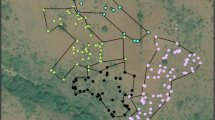Abstract
Signaling often involves complex suites of behaviors that incorporate different sensory modalities. Whatever modality is used to establish that a signal functions in communication researchers must demonstrate that receivers respond to it. The territory defense response of male swamp sparrows involves a variety of behaviors that includes both vocal and visual displays. One of these, the “wing wave” display, is a distinctive movement that predicts physical attack. Here, we use robotic taxidermic mounts paired with song to test the hypothesis that wing waving is a signal and, specifically, that male receivers respond to wing waving as a signal of aggressive intent. As predicted, subjects responded more aggressively to the mount during wing waving trials than during stationary trials. A second experiment demonstrated that this effect cannot be attributed simply to increased attention to movement. Less expectedly, subjects did not alter their own display behavior in response to wing waving as compared to a static mount. We conclude that the wing wave display in the context of singing is a signal that functions in male–male aggressive communication. Questions remain, including whether wing waving functions as a signal in the absence of singing and whether wing waving and song are redundant signals or communicate different information.



Similar content being viewed by others
References
Altmann J (1974) Observational study of behavior: sampling methods. Behaviour 49:227–266
Anderson RC, Searcy WA, Nowicki S (2008) Soft song in song sparrows: acoustic structure and implications for signal function. Ethology 114:662–676
Anderson RC, Searcy WA, Hughes M, Nowicki S (2012) The receiver-dependent cost of soft song: a signal of aggressive intent in songbirds. Anim Behav 83:1443–1448
Andersson M (1982) Female choice selects for extreme tail length in a widowbird. Nature 99(818):820
Ballentine B (2009) The ability to perform physically challenging songs predicts age and size in male swamp sparrows, Melospiza georgiana. Anim Behav 77:973–978
Ballentine B, Hyman J, Nowicki S (2004) Vocal performance influences female response to male bird song: an experimental test. Behav Ecol 15:163–168
Ballentine B, Searcy WA, Nowicki S (2008) Reliable aggressive signalling in swamp sparrows. Anim Behav 75:693–703
Balsby TJS, Dabelsteen T (2002) Female behaviour affects male courtship in whitethroats, Sylvia communis: an interactive experiment using visual and acoustic cues. Anim Behav 63:251–257
Beecher MD, Stoddard PK, Campbell SE, Horning CL (1996) Repertoire matching between neighbouring song sparrows. Anim Behav 51:917–923
Bradbury J, Vehrencamp S (2011) Principles of animal communication. Sinauer, Sunderland
Burford FRL, McGregor PK, Oliveira RF (2000) Response of fiddler crabs (Uca tangeri) to video playback in the field. Acta Ethol 3:55–59
Burt JM, Campbell SE, Beecher MD (2001) Song type matching as threat: a test using interactive playback. Anim Behav 62:1163–1170
Candolin U (2003) The use of multiple cues in mate choice. Biol Rev 78:575–595
Clark DL, Uetz GW (1992) Morph-independent mate selection in a dimorphic jumping spider: demonstration of movement bias in female choice using video-controlled courtship behaviour. Anim Behav 43:247–254
Davies NB, Lundberg A (1984) Food distribution and a variable mating system in the dunnock, Prunella modularis. J Anim Ecol 53:895–912
DuBois AL, Nowicki S, Searcy WA (2009) Swamp sparrows modulate vocal performance in an aggressive context. Biol Lett 5:163–165
DuBois AL, Nowicki S, Searcy WA (2011) Discrimination of vocal performance by male swamp sparrows. Behav Ecol Sociobiol 65:717–726
Falls J (1992) Playback: A historical perspective. In: McGregor P (ed) Playback and studies of animal communication. Plenum, New York, pp 11–33
Gerhardt H, Huber F (2002) Acoustic communication in insects and anurans. University of Chicago Press, Chicago
Gottlander K (1987) Variation in the song rate of the male pied flycatcher Ficedula hypoleuca: causes and consequences. Anim Behav 35:1037–1043
Greenberg R (1988) Seasonal plumage dimorphism in the swamp sparrow (Melospiza georgiana). J Field Ornithol 59:149–154
Hasson O (1989) Amplifiers and the handicap principle in sexual selection: a different emphasis. Proc R Soc B 235:383–406
Hebets EA, Papaj DR (2005) Complex signal function: developing a framework for testable hypotheses. Behav Ecol Sociobiol 57:197–214
Hill GE (1991) Plumage coloration is a sexually selected indicator of male quality. Nature 350:337–339
Johnstone RA (1996) Multiple displays in animal communication: ‘backup signals’ and ‘multiple messages’. Phil Trans R Soc B 351:329–338
King AP, West MJ (1977) Species identification in the North American cowbird: appropriate responses to abnormal song. Science 195:1002–1004
Krebs JR, Ashcroft R, Webber M (1978) Song repertoires and territory defence in the great tit. Nature 271:539–542
Marler P (1967) Animal communication signals. Science 157:769–774
Martof BS, Thompson EF (1958) Reproductive behaviour of the chorus frog, Pseudacris nigrita. Behaviour 13:243–258
Møller AP (1988) Female choice selects for male sexual tail ornaments in the monogamous swallow. Nature 332:640–642
Møller AP, Pomiankowski A (1993) Why have birds got multiple sexual ornaments? Behav Ecol Sociobiol 32:167–176
Narins PM, Hödl W, Grabul DS (2003) Bimodal signal requisite for agonistic behavior in a dart-poison frog, Epipedobates femoralis. Proc Natl Acad Sci USA 100:577–580
Nelson DA, Marler P (1989) Categorical perception of a natural stimulus continuum: birdsong. Science 244:976–978
Nice MM (1943) Studies in the life history of the song sparrow II: the behavior of the song sparrow and other passerines. Trans Linn Soc NY 6:1–328
Nowicki S, Searcy WA, Hughes M, Podos J (2001) Motor performance and the evolution of birds song: male and female response to song innovation in swamp sparrows. Anim Behav 62:1189–1195
Partan SR, Marler P (2005) Issues in the classification of multimodal communication signals. Am Nat 166:231–245
Partan SR, Larco CP, Owens MJ (2009) Wild tree squirrels respond with multisensory enhancement to conspecific robot. Anim Behav 77:1127–1135
Patricelli GL, Uy JAC, Walsh G, Borgia G (2002) Sexual selection: male displays adjusted to female's response. Nature 415:279–280
Pauly GB, Bernal XE, Rand AS, Ryan MJ (2006) The vocal sac increases call rate in the Tungara frog Physalaemus pustulosus. Physiol Biochem Zool 79:708–719
Peters S, Searcy WA, Marler P (1980) Species song discrimination in choice experiments with territorial male swamp and song sparrows. Anim Behav 28:393–404
Petrie M, Halliday T (1994) Experimental and natural changes in the peacock's (Pavo cristatus) train can affect mating success. Behav Ecol Sociobiol 35:213–217
Rohwer S (1977) Status signaling in Harris sparrows: some experiments in deception. Behaviour 61:107–129
Rowe C (1999) Receiver psychology and the evolution of multicomponent signals. Anim Behav 58:921–931
Rowland WJ (1995) Do female stickleback care about male courtship vigor? Manipulation of display tempo using video playback. Behaviour 132:951–961
Searcy WA, Beecher MD (2009) Song as an aggressive signal in songbirds. Anim Behav 78:1281–1292
Searcy W, Nowicki S (2005) The evolution of animal communication: reliability and deception in signaling systems. Princeton University Press, Princeton
Searcy WA, Anderson RC, Nowicki S (2006) Bird song as a signal of aggressive intent. Behav Ecol Sociobiol 60:234–241
Taylor RC, Klein BA, Stein J, Ryan MJ (2008) Faux frogs: multimodal signalling and the value of robotics in animal behaviour. Anim Behav 76:1089–1097
van Doorn GS, Weissing FJ (2006) Sexual conflict and the evolution of female preferences for indicators of male quality. Am Nat 168:742–757
Weeden JS, Falls JB (1959) Differential responses of male ovenbirds to recorded songs of neighboring and more distant individuals. Auk 76:343–351
Wilson EO (1965) Chemical communication in the social insects. Science 149:1064–1071
Wishart G, Riordan DF (1959) Flight responses to various sound by adult males of Aedes aegypti L. (Diptera, Culicidae). Can Entomol 91:181–191
Acknowledgments
We thank Jason Dudley at Whistlin’ Wings Taxidermy, Raleigh, North Carolina, USA, for preparing the taxidermic mount used in the wing waving experiment, and Meng Kang and Martin Steren for their assistance with the design and creation of the actuator mechanism and controller used to animate this mount. We thank Susan Peters for her support throughout the study and for her help with preparing playback stimuli. Robert Lachlan kindly provided his photo of a wing waving swamp sparrow. Thanks to three anonymous reviewers whose suggestions improved the manuscript. Funding was provided by the Duke University Office of the Provost; access to field sites was granted by the Pennsylvania State Game Commission, and logistical support in the field was provided by the Pymatuning Laboratory of Ecology of the University of Pittsburgh.
Ethical standards
All work conforms to the ABS/ASAB guidelines for the treatment of animals in behavioural research and teaching and was approved by the Duke Institutional Animal Care and Use Committee (protocol no. A061-11-03) and the University of Pittsburgh Institutional Animal Care and Use Committee (protocol no. 12030268).
Author information
Authors and Affiliations
Corresponding author
Additional information
Communicated by D. Rubenstein
Electronic supplementary material
Below is the link to the electronic supplementary material.
(M4V 7801 kb)
(M4V 17651 kb)
Rights and permissions
About this article
Cite this article
Anderson, R.C., DuBois, A.L., Piech, D.K. et al. Male response to an aggressive visual signal, the wing wave display, in swamp sparrows. Behav Ecol Sociobiol 67, 593–600 (2013). https://doi.org/10.1007/s00265-013-1478-9
Received:
Revised:
Accepted:
Published:
Issue Date:
DOI: https://doi.org/10.1007/s00265-013-1478-9




